Situated in East London, two flights up, is Come to Church, a studio that tattoo artist Mara Dentini opened a few years ago. When I visit the studio in the sweltering summer heat, the windows are open and the breeze is heavy. Guests awaiting a tattoo can sit on a plush white couch and admire the interior. Like its name, the studio is aesthetically Catholic, filled with lace doilies, religious paintings, and vintage books about the art of the church. Within minutes, Mara, who tattoos under the name SSTR (pronounced sister), is offering you biscuits and coffee, served on a silver platter with matching cutlery. It’s clear that there’s an attention to detail not only within the space but also with every dot Mara tattoos.
Her tattoos are well known for their delicate design. Similar to embroidery, the patterns often feature florals and vary in size. Within minutes of sitting down in her chair, it’s clear why this style of tattoo has become almost synonymous with her name. “Every day you have to do your best,” she says. “Every day is the big day.” And because she treats it as such, she has a fervent following. She’s been tattooing for seven years after training as an artist in college, though the idea of tattooing didn’t come to her until after graduation. During her time at the Academy of Fine Arts in Florence, she was taught that “you can’t even mention a medium that is not all on canvas as art.” Now, she’s running her own studio and gaining traction as one of the most exciting tattoo artists in the industry.
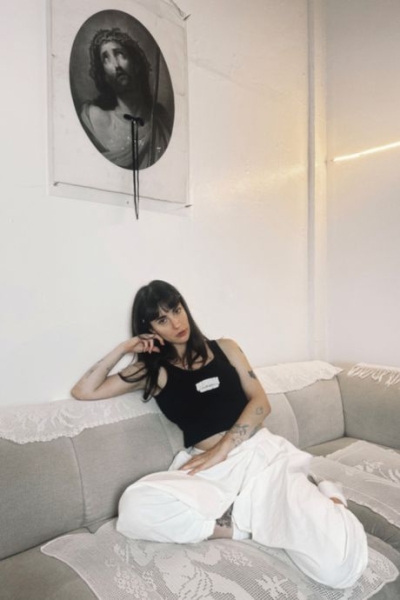
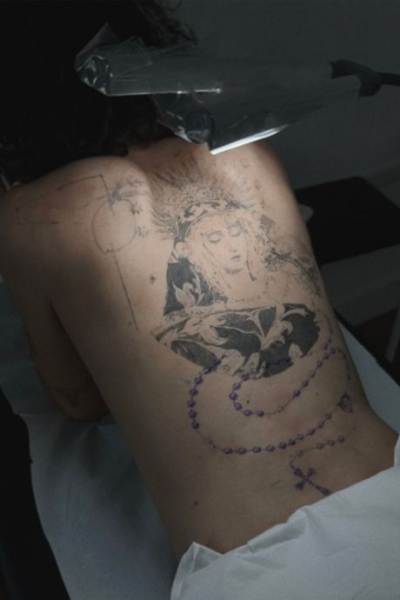
Mara at the studioher tattoos Mara at the studioher tattoos
How did you get into tattooing?
I started when I was 29, and it was an accident. I gave myself my first tattoo. I was going through a breakup and, you know, when you want to do something crazy, like cut your hair or whatever. Well, I bought a hand-poke kit and gave myself a tattoo. Not only did that help the cathartic process of getting over the breakup, but the minute I gave myself that tiny tattoo, I was like, This is it. Up until then, I was just a sad artist because I was not finding my angle. It’s funny, because I have so many young people who come to me now. Some of my clientele are in their early 20s, and we chat, and they’re like, “I don’t know what to do with my life. I’m 22 and I still have not figured it out.” And I’m like, “Don’t worry, sister. It’s never too late.”
When did you first know you wanted to be an artist?
Starting from my childhood, I was always a talented kid. Even in kindergarten, the nuns made me do the Christmas decorations because I was the only kid who could draw inside the lines. And then I went to the Academy of Fine Arts in Florence, and after that I moved to London. But when I graduated, I waited a couple of years, just doing random jobs, and then I did my master’s at Central Saint Martins. That time between fine art and my master’s, when I moved to London, I didn’t want anything to do with art. I didn’t want to be an artist. I was very lost.
Why?
The academy was not the most positive experience for me. At my graduation, my painting teacher stood up, and in front of my parents and my friends, said, “I don’t know how this person can call themselves an artist; they never should have been here.” I knew he was wrong, but I had no other feedback from anyone else at the time, so it hurt. The education system in Italy is not there to bring out what’s in you or your potential. It’s just fitting into a box. It’s been like that since the Renaissance. And while I was critical of it for many years, it must be good for people who want to do fine art. But what they were teaching you is “You make art for yourself. It’s got to be your self-expression, and eventually someone will discover you, and it’s going to make you great. But it may be when you’re dead.” You know that artist rhetoric, where you’ve got to be content just creating and nothing else matters. And I’m like, I don’t want to be sad and poor forever.
How does that experience impact your work now?
From the academy, I’ve learned all the technical skills I need. Anything that has to do with the precision of the craft. I want to make something well made and something beautiful. If you go to Florence, everywhere you turn is a chapel or a Michelangelo. I wanted to keep that. Even what I do now, using lace as a way to create tattoos, I’m bringing back something that is technically quite old and stale, but it is beautiful, and I’m creating something new.
On the other hand, the Academy experience filled me with rage. I’ve always been against conforming too much to authority, and even when I started tattooing, I encountered pretty much the same sort of obstacles. Seven years ago, I was starting to tattoo in the London industry, which was not quite ready for what I was doing. Now, it’s pretty much everywhere, but at the time, hand-poking was not much of a thing, and delicate tattoos were not as accepted as they are now. So when I was first starting to approach tattoo studios, it was mainly the male-run, traditional tattoo-shop scene. I was told, “These are not real tattoos. You can’t tattoo.” And I was like, “Watch me.”
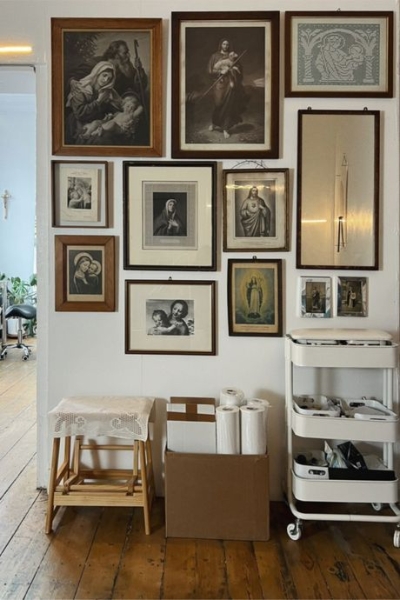
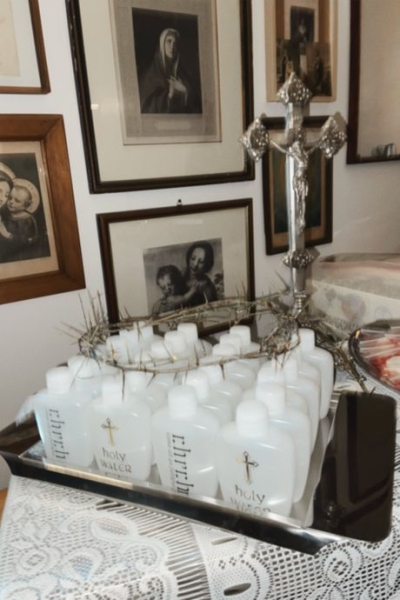
The Mary wall inside the studio. The Mary wall inside the studio.
Catholicism is a big part of your work as well. Tell me about that. What’s your relationship with religion?
I grew up religious. In Italy, there’s not much of an option. You have to get baptized, and you do the Catechism on a Saturday and go to church on Sunday. I think I was about 8 when I asked my mom, “What is this God thing? It doesn’t make sense to me.” But I do love a church. I love a religious portrait. There’s just something in the beauty and aesthetic of it. I’m a Mary girl, and not much of a Jesus girl. I love some symbology of the Catholic world, like Mary’s always a bit sad and a bit gothic. She’s always portrayed with swords in her heart and crying. I do like the dark side of it.
Click here to preview your posts with PRO themes ››
All the countless hours I had to sit in church, obviously, my brain was not in it, but I had to sit in those pews and with the high ceilings and the smell of incense, and that just became part of me. So when I started looking for my angle in my designs and what made them unique, it came from that. So even the studio — now I call it Church. A lot of people, when they come in, they ask me if I’m religious, or if they have to be religious to work in there, but it’s pretty obvious that it’s ironic.
Where were you tattooing before your studio?
When I was still doing my master’s at Central Saint Martins, I was putting up flyers saying “20-pound tattoos on my couch,” and that’s how I got the first few people coming in. It’s surprising how many people are willing to get a 20-pound tattoo. I’m like, What did your mom teach you? It’s crazy to me that people were actually going to a stranger’s house to get a pretty much free tattoo. But yeah, I was living in East London, in Clapton, with my sister, who hates tattoos, and I was tattooing people on a couch. Now she’s the one who runs my studio.
Wait, that’s so cute. Is that why your name is SSTR?
I feel strong in my role as a big sister toward my clients but also toward her. In fact, I sacrifice a lot of my salary to employ her full time. It’s been three years now.
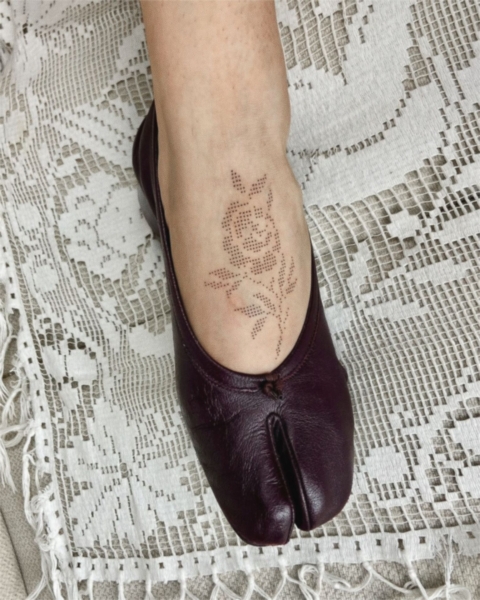
Your style of delicate hand poke has gotten more popular. When did you first start seeing copies of your work, and how do you feel about all that?
At some point, I asked my sister to run a Pinterest account for me, and a few pieces went viral. I do a lot of similar ones — the rose on the foot with a Tabi or ballerina shoe, which also intersected with the fashion girls — and I’ve seen a few pretty much identical styles of pictures. But I noticed an increase in popularity when I opened a Pinterest account. On Pinterest, your photo becomes a nameless image, where people save it in their favorites. I have my sister, with a burner account, credit me when she sees my pictures. Not in an egomanic way but to keep track for myself. At the same time, I take it as a positive thing. It’s an honor to see something that I started and to see that my intuition resonates, because that is the important thing. When I see other people doing it, it confirms that I was right. Going back to the people who said I can’t do this, this is not a thing. It’s proof that it is very much a thing.
Where does your inspiration come from when designing new tattoos?
It’s mainly online, through obscure Russian or Polish websites where some grandma posted lace patterns. As much as lace is nice, it doesn’t always make a nice tattoo. It’s got to be the right pattern, whether lace or crochet, and then I replace the squares with a dot. You should see me when I go back to Italy, my mom and me: We leave at 8 a.m. to go to the street markets, and there are piles of lace and doilies on sale for cents, probably from people who died. And it’s me, a nun, and two ladies in their 70s trying to grab the best lace pieces. That’s also where I find the ones that I have in my studio. And I have a lace dealer in Florence.
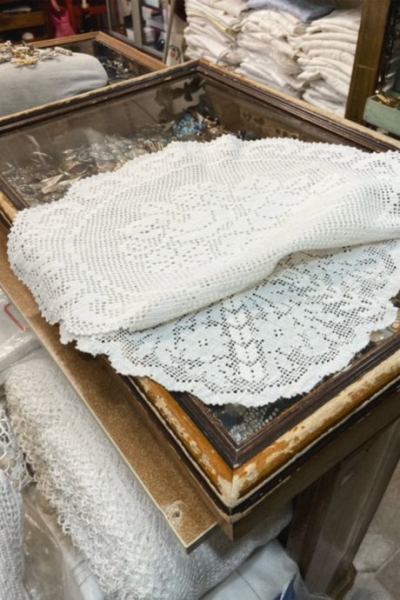
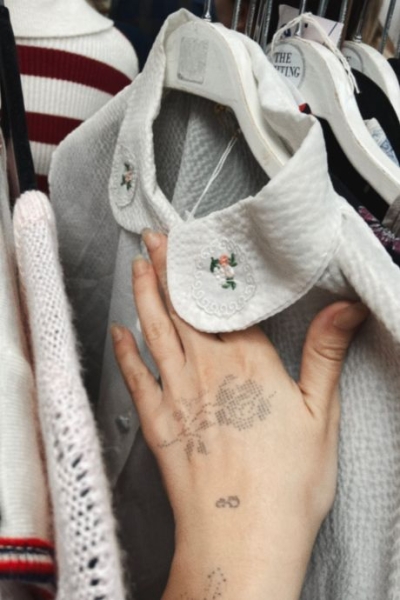
You get a lot of fashion-girl clients for tattoos. How did you make yourself fashion adjacent, and how would you describe your style?
We kind of find each other. I try to convey a sense of aesthetic, and they know. When I take a picture of a tattoo, I don’t take a picture just of the square of skin. I like to incorporate something from the outfit they’re wearing, because tattoos are almost like a fashion accessory now, like something that complements the style of the person. I’m always in black or in frilly gowns. But I buy most stuff secondhand; I’m thrifty. The main thing I wear is Adidas. That is my uniform. Someone told me that the style is called health goth — sort of like athletic and dark.
What do you listen to when you tattoo?
True-crime podcasts. My sister made a Reel of me tattooing, and the caption said, “What my sister listens to when she tattoos.” It’s me looking very peaceful with my headphones on, and the audio says, “Her head was cut off. Her arm was cut off. Her tongue was cut off.” [Laughs] I have an explanation for this. I have a dark soul, and I lean very much into that. But I find that it really works for me to help me focus and be in the zone to have some kind of narration that is flat and linear. It could also be audiobooks. I listened to The Lord of the Rings and Twilight, but it can’t be like a comedy podcast. It can’t be anything funny, because then the mood is up and down. I need something quite somber and flat. And true crime is gripping. It keeps you in the zone, and it’s dark as fuck.
Do you have a dream person you’d want to tattoo?
FKA Twigs; she lives around the corner. I’m manifesting tattooing Gabbriette. And Ethel Cain would love my studio.
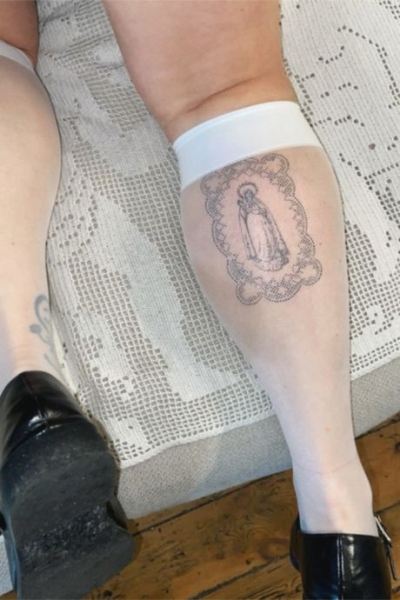
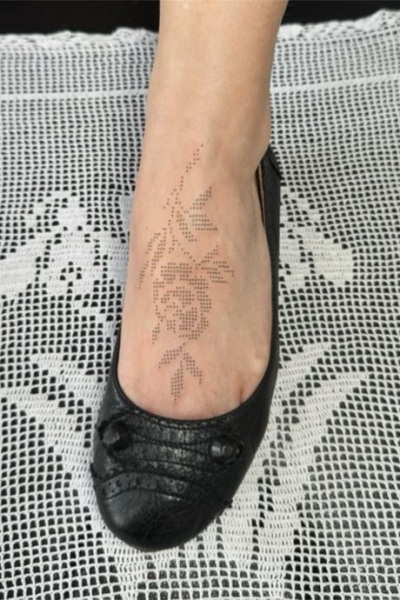
From left: From top:


